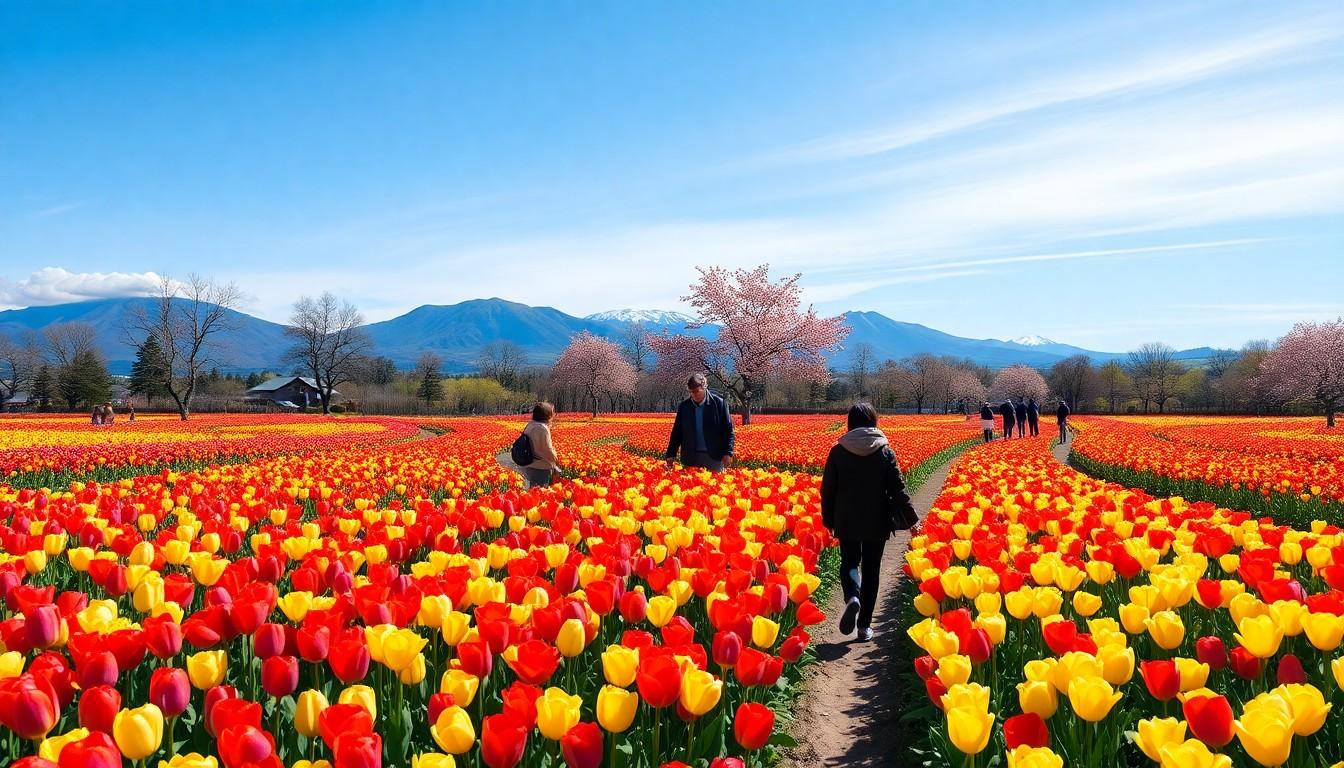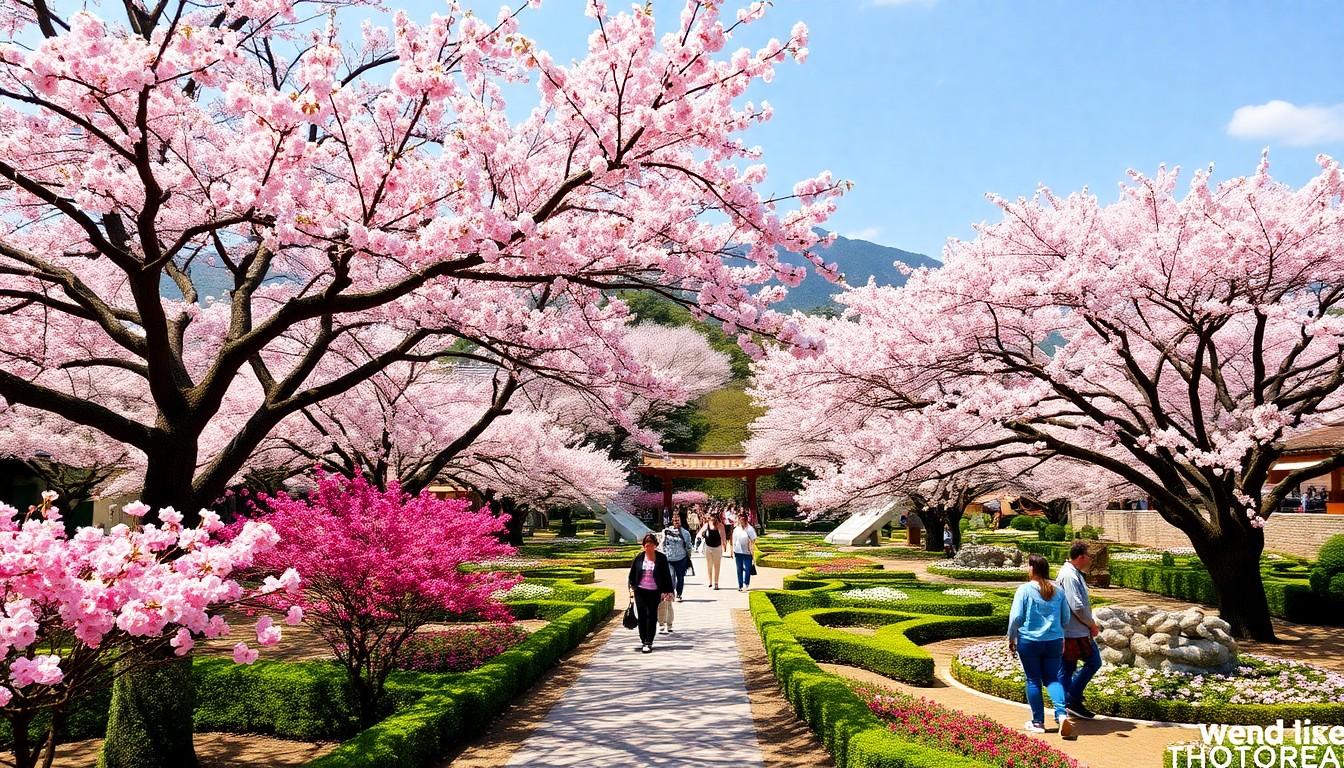Imagine strolling through a vibrant tapestry of colors, where cherry blossoms dance in the breeze and irises proudly flaunt their hues. Welcome to the enchanting world of flower gardens in Japan, a paradise that feels like a painter’s palette come to life. From the iconic sakura blooms to the breathtaking fields of lavender, these gardens offer a sensory feast that’s sure to leave anyone spellbound.
Flower Garden Japan
Flower gardens in Japan showcase a rich diversity of flora, with each season presenting unique blooms. Cherry blossom trees, or sakura, hold a special place in Japanese culture, attracting thousands of visitors during Hanami season. Lavender fields in Hokkaido offer breathtaking vistas, particularly during July when the vibrant purple hues are at their peak.
Numerous locations throughout Japan host remarkable flower festivals, including the famous Gifu’s Flower Park. Seasonal festivals display tulips, sunflowers, and chrysanthemums, allowing visitors to appreciate the extensive plant varieties. Many gardens feature meticulously arranged landscapes, harmonizing with traditional Japanese aesthetics, emphasizing balance and tranquility.
Famous gardens, such as Kenrokuen in Kanazawa and Shinjuku Gyoen in Tokyo, offer picturesque scenes year-round. Visitors often experience the seasonal changes, witnessing cherry blossoms in spring, lush greenery in summer, and colorful foliage in autumn.
In addition, some gardens cultivate rare species endemic to Japan, enhancing their ecological significance. Natural beauty complements historical sites, enriching the experience for travelers seeking cultural immersion. The tranquility found within flower gardens invites reflection and appreciation of nature’s artistry.
Ultimately, exploring Japan’s flower gardens presents an unforgettable sensory journey, deeply rooted in tradition and beauty. The combination of seasonal blooms, serene environments, and cultural heritage make these gardens an essential aspect of Japan’s charm.
Popular Flower Garden Destinations

Japan boasts numerous flower garden destinations that charm visitors with their breathtaking displays.
Tulip Gardens
Hokkaido features iconic tulip gardens that attract tourists each spring. Kamiyubetsu Tulip Park showcases over 1,200 varieties of tulips, creating a stunning mosaic of colors. Visitors often revel in the vibrant landscape, especially during the Tulip Festival in May. Furthermore, the park contains a tulip labyrinth, allowing guests to wander through intricate pathways formed by blooming flowers. Each year, thousands enjoy the sights and scents, marking a delightful experience for families and flower enthusiasts alike.
Cherry Blossom Parks
Cherry blossoms, known as sakura, transform parks across Japan into pink-hued wonderlands during hanami season. Ueno Park in Tokyo stands out with approximately 1,000 cherry trees lining its pathways. People gather for picnics beneath the blossoms, fostering a sense of community and appreciation for nature. Furthermore, Maruyama Park in Kyoto becomes a popular nighttime destination as lanterns illuminate the trees, creating a magical atmosphere. Annual cherry blossom festivals celebrate this fleeting beauty, offering food, entertainment, and cultural experiences for all visitors.
Lavender Fields
Hokkaido’s lavender fields offer breathtaking landscapes, especially in July. Farm Tomita is a famous attraction, showcasing extensive rows of vibrant purple lavender against a backdrop of mountains. Visitors appreciate the stunning views and the therapeutic scent the flowers provide. Fields at this farm also include various other blooms, enhancing the picturesque experience. Notably, the lavender harvested here contributes to local products, making it a significant destination for both tourists and locals alike.
Seasonal Highlights
Flower gardens in Japan offer breathtaking displays throughout the year, with each season bringing its own unique blooms and colors.
Spring Blooms
Sakura, or cherry blossoms, dominate Japan’s spring scene. Pink and white petals create stunning canopies across parks like Ueno and Maruyama. Visitors flock to these iconic locations during Hanami to celebrate the fleeting beauty of nature. Tulips también emerge in various hues, particularly in Hokkaido, where Kamiyubetsu Tulip Park showcases over 1,200 varieties. These vibrant gardens invite exploration and offer festive atmosphere, creating memorable experiences.
Summer Displays
Vibrant summer gardens burst with color. Sunflowers stretch toward the sun in numerous parks, while Hokkaido’s lavender fields reach their peak in July. Farm Tomita captivates visitors with its aromatic lavender blooms, providing scenic views and fragrant experiences. Colorful hydrangeas bloom in late spring through summer, adding serene beauty to gardens. Festivals and local markets during this season celebrate the rich floral diversity, attracting flower enthusiasts from around the globe.
Autumn Colors
Autumn transforms gardens into vivid landscapes. Chrysanthemums, known as kiku, bloom in rich reds, yellows, and purples, symbolizing longevity and joy in Japanese culture. Many renowned gardens, like Kenrokuen, host chrysanthemum festivals showcasing large, intricately arranged displays. Maples display fiery colors, creating picturesque backdrops as leaves change. Such seasonal transitions invite reflection and appreciation for the natural beauty found in Japanese gardens, enriching each visit during this enchanting season.
Cultural Significance of Flower Gardens
Flower gardens in Japan embody deep cultural and historical meanings. Cherry blossoms, or sakura, play a central role in Japanese culture, symbolizing the transient nature of life, and Hanami celebrations draw thousands to gather and appreciate their fleeting beauty. Each spring, communities unite under blooming cherry trees, fostering connections and a sense of belonging.
Traditional Japanese aesthetics prioritize balance and tranquility, concepts embodied in garden designs. Carefully curated landscapes reflect harmony with nature, allowing for contemplative experiences that resonate with the Japanese ethos. Gardens often serve as spaces for meditation and reflection, encouraging visitors to appreciate the artistry found in nature.
Seasonal festivals celebrate various blooms, reinforcing communal ties. Events like the Gifu Flower Park Festival showcase a dazzling array of flowers, while local tulip and sunflower festivals invite participation from families and friends. These gatherings promote cultural exchange and strengthen local identities.
Regional flowers also hold specific meanings within different communities. For instance, chrysanthemums represent resilience and longevity, making them significant in autumn celebrations. Lavender, particularly in Hokkaido, symbolizes purity and calm, attracting visitors seeking relaxation and therapeutic experiences.
Many flower gardens, such as Kenrokuen and Shinjuku Gyoen, preserve not only plant diversity but also rich heritage. Visitors find joy in exploring these spaces, experiencing seasonal transitions and regional traditions. Flower gardens in Japan reflect the country’s values, vividly depicting nature’s beauty through centuries of cultural significance.
Tips for Visiting Flower Gardens in Japan
Plan visits during peak bloom seasons for the most vibrant displays. For cherry blossoms, expect peak bloom from late March to early April. Summer showcases lavender fields in Hokkaido, particularly from late June to early July, attracting numerous tourists.
Travel early in the day to avoid crowds and enjoy a more peaceful experience. Morning visits offer cooler temperatures and enhanced tranquility, ideal for appreciating the gardens’ beauty. Strolling through the gardens with fewer people creates a more intimate connection with nature.
Consider purchasing tickets in advance for popular gardens, especially known hotspots like Ueno Park or Farm Tomita. Online reservations often ensure entry and can reduce waiting times during busy seasons. Make sure to check the opening hours, as they can vary by season.
Carry a camera to capture breathtaking moments. Stunning frames await at every turn, from vast tulip fields to delicate cherry blossoms. Photographers should explore various angles and lighting for the best shots.
Stay hydrated and wear comfortable shoes. Walking through expansive gardens often involves significant distances, especially in open areas like Kamiyubetsu Tulip Park. Hydration ensures a pleasant experience.
Respect nature and garden etiquette. Stay on designated paths to avoid damaging flowers and plants. Observing local customs adds to the experience while showcasing appreciation for Japan’s cultural heritage.
Explore local festivals during visits. Seasonal celebrations, like the Gifu Flower Park Festival, enrich the experience with food, music, and community activities. These events reveal the deeper cultural significance of flowers within Japanese society.
Unique Blend of Natural Beauty and Cultural Significance
Japan’s flower gardens offer a unique blend of natural beauty and cultural significance that captivates visitors year-round. Each garden tells a story through its seasonal blooms and meticulously designed landscapes. Whether experiencing the fleeting beauty of cherry blossoms or the vibrant hues of summer sunflowers, there’s a profound sense of tranquility and connection to nature.
Exploring these gardens not only delights the senses but also fosters a deeper appreciation for Japan’s rich heritage. With each visit, travelers can immerse themselves in the artistry of flora while embracing the traditions that surround these breathtaking spaces. Flower gardens in Japan truly provide an unforgettable journey that resonates long after the visit.

